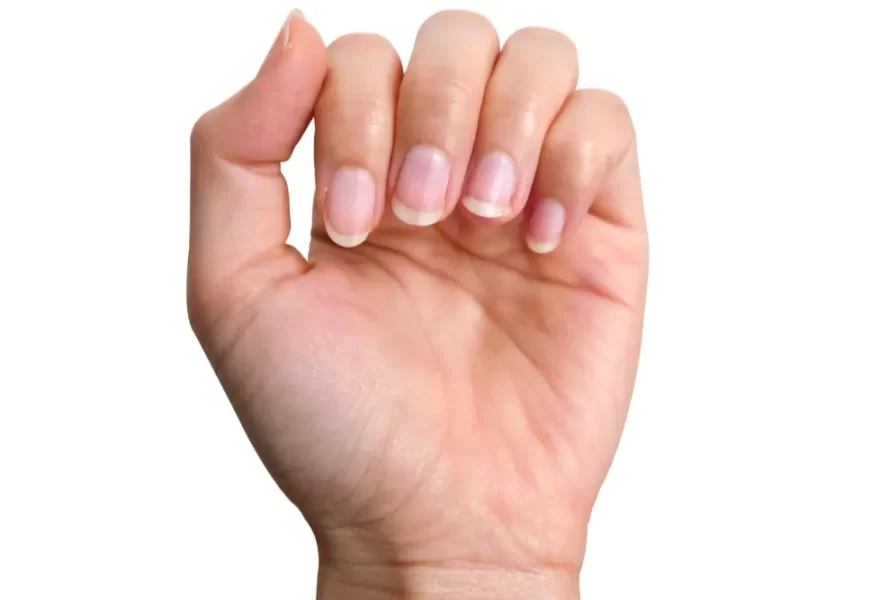Our bodies have a way of signaling potential health concerns, and our fingernails can reveal more than we realize. According to medical experts, certain changes in your nails might provide clues about your overall health, including potential underlying conditions that could affect your lifespan. While no single nail change can predict exactly how long you have to live, certain signs may indicate serious health risks that require immediate attention.
Let’s explore some key fingernail signs that doctors warn could be linked to your health and what they might mean for your well-being.
1. Pale or White Nails – Could Indicate Anemia or Liver Disease
If your nails appear pale, whitish, or have a faded look, it might be a sign of low red blood cell levels (anemia) or even liver disease such as cirrhosis. Anemia reduces oxygen circulation in the blood, which can lead to fatigue, dizziness, and weakness.
Other symptoms to watch for:
✔️ Unexplained tiredness
✔️ Shortness of breath
✔️ Cold hands and feet
If you notice your nails losing their healthy pinkish color, it’s best to consult a doctor for further evaluation.
2. Yellow Nails – A Sign of Lung Disease or Diabetes
Nails that turn yellow can be a result of several factors, including fungal infections. However, in some cases, yellow nails may signal more serious conditions like lung disease, diabetes, or even thyroid disorders.
Why does this happen?
🔹 Lung conditions like chronic bronchitis can affect oxygen levels, causing nail discoloration.
🔹 Diabetes can lead to poor circulation, resulting in yellowing nails.
If you have yellow nails along with difficulty breathing, swelling in the legs, or slow-healing wounds, seek medical advice.
3. Dark Lines Under the Nails – Could Be a Sign of Skin Cancer
Thin or thick dark lines running vertically under the nails might be a warning sign of subungual melanoma, a rare but dangerous type of skin cancer.
Key signs to look for:
✔️ A single, dark streak that appears without injury
✔️ Changes in nail texture or thickness
✔️ A line that grows or spreads over time
If you spot suspicious dark streaks on your nails, don’t ignore them—consult a doctor immediately for a thorough checkup.
4. Spoon-Shaped Nails – Could Indicate Iron Deficiency
If your nails have a concave, spoon-like shape, where they curve inward instead of outward, this could be a sign of iron deficiency (anemia) or even heart disease.
Why does this happen?
🔹 Low iron levels affect oxygen transport, causing structural changes in the nails.
🔹 Spoon nails may also indicate autoimmune disorders or liver conditions.
Other symptoms that may accompany spoon nails:
✔️ Brittle nails that break easily
✔️ Fatigue and weakness
✔️ Frequent headaches
Eating iron-rich foods like spinach, red meat, and beans can help, but it’s important to get a blood test to confirm iron levels.
5. Ridges or Grooves in the Nails – Could Signal Nutrient Deficiencies or Chronic Illness
If you notice horizontal or vertical ridges on your nails, it could indicate nutrient deficiencies, high stress levels, or even underlying health conditions like diabetes and kidney disease.
🔹 Vertical ridges are often harmless and related to aging.
🔹 Deep horizontal ridges (Beau’s lines) may indicate a history of serious illness, infections, or malnutrition.
If these ridges appear suddenly and are accompanied by other symptoms like fatigue, unexplained weight loss, or weakness, a medical consultation is recommended.
6. Clubbed Nails – May Point to Lung or Heart Disease
Clubbed nails occur when the tips of the fingers enlarge, and the nails curve downward, forming a rounded shape. This condition is often associated with low oxygen levels in the blood, which can be linked to lung disease, heart disease, or liver issues.
Signs of nail clubbing:
✔️ Nails appear rounded and swollen
✔️ The nail bed becomes soft or spongy
✔️ Fingers may appear thicker
If you experience clubbing along with breathing difficulties or chronic cough, you should consult a healthcare provider immediately.
7. Brittle, Cracked, or Splitting Nails – Could Be a Sign of Thyroid Disease
If your nails frequently crack, split, or become excessively dry, this could be a sign of hypothyroidism (underactive thyroid). The thyroid gland plays a crucial role in regulating metabolism and cell growth, and when it’s not functioning properly, it can lead to changes in the nails.
Other symptoms of thyroid dysfunction:
🔹 Dry skin and hair thinning
🔹 Unexplained weight changes
🔹 Constant fatigue
A simple thyroid function test can help determine if you have a thyroid disorder.
8. Half-and-Half Nails – Linked to Kidney Disease
Half-and-half nails (also called Lindsay’s nails) are characterized by a white upper half and a pink or reddish lower half. This can be a sign of chronic kidney disease, which affects the body’s ability to filter waste and toxins from the blood.
Symptoms of kidney issues that may accompany nail changes:
✔️ Swelling in the legs and feet
✔️ Frequent urination or changes in urine color
✔️ High blood pressure
If you notice this type of nail discoloration along with other kidney-related symptoms, seek medical evaluation.
9. White Spots on Nails – Usually Harmless but Sometimes a Warning Sign
White spots on nails are common and often caused by minor injuries or trauma. However, if white spots persist or increase, they could be a sign of:
🔹 Zinc or calcium deficiency
🔹 Fungal infections
🔹 Kidney or liver problems (in rare cases)
To prevent deficiencies, eat a balanced diet rich in vitamins and minerals.
Final Thoughts
Your nails can serve as early warning signs of underlying health conditions. While not every nail change indicates a serious illness, persistent or sudden changes should never be ignored. If you notice discoloration, ridges, clubbing, or sudden brittleness, it’s always best to consult a doctor for a proper diagnosis.
Staying informed about your body’s signals can help you take preventative steps to protect your long-term health. After all, small changes in your fingernails could be the first clue that your body needs attention.




